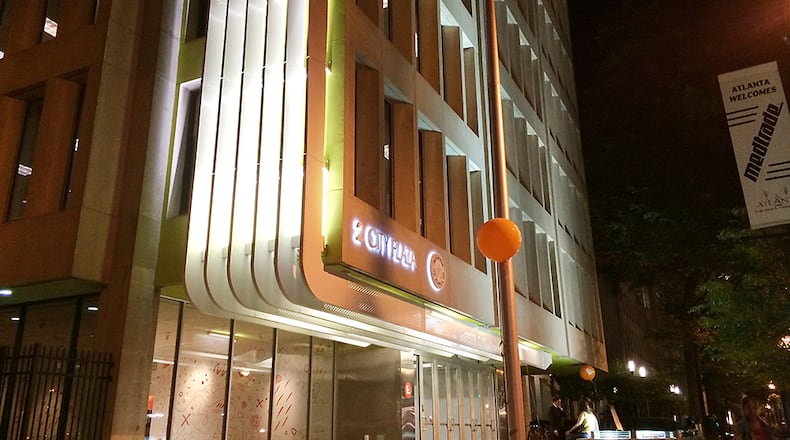Even longtime Atlanta residents can get confused when referring to “the old Constitution building.” The Atlanta Journal and Atlanta Constitution newspapers have held 14 addresses between them since 1868.
The paper — with its digital and multimedia newsroom — will call Peachtree Street home for the first time when the AJC relocates to Midtown in the fall of 2024.
To sort out all of those locations, here’s a history of the Journal and Constitution headquarters and who would have filed their reports from which office.
These are the buildings where Ralph McGill read angry letters to the editor; where Joel Chandler Harris and Margaret Mitchell worked their day jobs; and where Celestine Sibley, Lewis Grizzard and Furman Bisher covered Dixie like the dew (except for Sibley, who only worked for the Constitution). Revisit these moments and more from the paper’s 150th anniversary.
CONSTITUTION: Alabama Street (1868-1869?)
The Atlanta Constitution was founded in 1868, when Civil War veteran Carey W. Styles bought the Atlanta Daily Opinion with financial backing from James H. Anderson and W.A. Hemphill, a future Atlanta mayor. Styles, who would soon relinquish his stake in the venture, renamed the paper The Constitution. The “Constitution” name refers to the Georgia state constitution, which had been superseded by martial law in those years right after the war. The new paper joined a crowded field, including The New Era, The Daily Sun, and the well-established Intelligencer. According to Franklin Garrett’s “Atlanta and Its Environs,” Styles published an invitation for readers to visit his new offices: “The Constitution office is located on Alabama Street, next door to the Ladies’ Entrance of the United States Hotel, first floor. … The Editor’s Sanctum is in the rear of the same.”
CONSTITUTION: 8 South Broad Street (1869?-1873?)
By 1870, the paper had moved around the corner to this address. This block of South Broad Street was squeezed between the railroad tracks and Alabama Street, and was home to a row of competing newspaper offices. The newspapers preferred to stay within a block of the tracks for easy unloading of newsprint. By 1874, the paper had a new address on the same block. It’s unclear whether it moved a few doors down, or whether the street numbering changed. Today, that block is occupied by the Five Points MARTA station. This photo shows the intersection of Broad and Alabama streets, looking toward the block where the newspaper offices would have been.
CONSTITUTION: 34 South Broad Street (1873?-1884)
Things got interesting for the Constitution in 1876, the year that Henry Grady and Joel Chandler Harris both joined the staff. Grady came from The Daily Herald, which had been a fierce competitor — and Broad Street neighbor — until it folded that year. Harris was an associate editor at the Savannah Morning News before being hired away by Grady. He began publishing his Uncle Remus stories in the Constitution in 1878 and worked at the paper until 1900.
A few illustrations exist that show what the handsome four-story building at 34 South Broad Street looked like. Besides this view, The Atlanta History Center holds another image that includes a large “Constitution” flag flying over the roof.
JOURNAL: 32 South Broad Street (1883-1890)
The Atlanta Journal launched in 1883, and for its first year was a next-door neighbor to the Constitution. This upstart was often a thorn in the side of the bigger paper and would eventually overtake it in circulation decades later.
JOURNAL: 10 South Broad Street (1890-1911)
Sometime around 1890, the Journal changed its address, although it’s unclear whether this was a move or a change in street numbering. This illustration is from one of the two South Broad Street addresses.
CONSTITUTION: 148 Alabama Street (1884-1947)
This grand Victorian building at the southeast corner of Alabama and Forsyth Streets was built during the peak of Editor Henry Grady’s influence — during this time, he was the leader of a group of political influencers known as the Atlanta Ring. The new Constitution building was a state-of-the art corporate palace for its time — the first in Atlanta to have an elevator and electric lights. (Click here for an image in the Atlanta History Center collection that shows the building in 1890.) While at this location, the paper launched its own radio station, WGM, which was later donated to Georgia Tech and renamed WGST. Another highlight: The Constitution won its first Pulitzer Prize in 1931 for exposing kickbacks in the construction of City Hall. And don’t forget Ralph McGill — he joined the paper in 1929 and became its editor-in-chief in 1942.
After 1947, the building continued to be used by Rich’s. By the time the building was demolished in 1967, the Alabama-Forsyth Street intersection was littered with old Constitution buildings (more on the other one later). Columnist Celestine Sibley wrote a column in 1995 reminiscing about her last night in this building before the paper moved.
JOURNAL: 7 Forsyth Street (1911-1949)
The Journal was a busy place during this era. Its circulation expanded and overtook the Constitution’s. In 1922, the Journal launched the radio station WSB, beating the Constitution by one day. Also that year, a young woman named Margaret Mitchell began as a staff writer. In 1939, former Ohio Gov. James M. Cox purchased the Journal and WSB Radio. And in 1948, the Journal won its first Pulitzer Prize for exposing vote fraud in Telfair County.
The photo above shows the newsroom where the magic happened. After the paper moved in 1949 to its new headquarters right across the street, the old 7 Forsyth location was remembered for being quite a dump. Today, the space is best known as the recent site of a former CVS Pharmacy that stretched from Forsyth to the Broad Street Plaza outside the Five Points MARTA station.
CONSTITUTION: 143 Alabama Street SW (1947-1953)
It wasn’t always an eyesore with roof vegetation. The building’s Art Moderne architectural style was unique to Atlanta at the time, and even in its current state of disrepair, the building remains on most local preservationists’ wish lists. The Constitution didn’t stay here very long. In 1950, James Cox purchased the paper and combined its Sunday edition with the Journal. In a few years, the Constitution would join the Journal at its new Forsyth Street address. Also in 1950, Furman Bisher began writing for the Constitution. He would later switch to the Journal and keep that allegiance for the rest of his life, no matter what the company’s name became.
Credit: Jason Getz
Credit: Jason Getz
After the Constitution moved out, Georgia Power continued to use the building until it was finally abandoned in 1972. In recent years, the site has been mentioned as a possible future transportation hub, which would spell doom for the building. Several preservation groups have called for finding a new use for the building and developers have proposed a number of projects over the years. In late 2024, a Wisconsin-based developer developer announced that the building, now owned by the city, would become affordable housing.
A few pieces of the building’s ornamentation were preserved and installed in new locations. A 72-foot-long bas-relief sculpture called “History of the Press” was removed from the building’s Forsyth front, and placed above the elevators in the Philips Arena/CNN MARTA station. The next time you’re going down, make sure to look up. Another architectural element from the Alabama Street building can be found outside the doors to Atlanta History Center’s McElreath Hall. That’s where you’ll see a large state seal that had been embedded in the floor of The Constitution’s entrance.
JOURNAL: 10 Forsyth Street (1949-1972)
This facility was actually two buildings of different architectural styles jammed together, much in the same way the Journal and Constitution would soon be jammed together within them. On the left was a stately office building with a stone front, and on the right was a modernist building with the production facilities. Pedestrians could watch the presses run from the large street-level windows. Look closely at the signage in this photo, and you’ll see the slogan “Covering Dixie Like the Dew” beneath the large “Journal” sign. Pay close attention to the words “The Atlanta Journal” attached to the wall under the sign. They would soon get an addition.
JOURNAL AND CONSTITUTION: 10 Forsyth Street (1953-1972)
The Constitution moved into the Journal’s new building in 1953, and both have been under the same roof ever since. The two newspapers were still competitors for six days of the week, despite the proximity and common ownership. In this photo from 1970, Gov. Lester Maddox and supporters picket the newspapers’ front entrance. Notice that the letters attached to the wall now include “and Constitution.”
The Constitution and Journal newsrooms were busy places in those decades, as this photo from Election Night 1954 attests. Other news was made here too – Editor Ralph McGill won a Pulitzer in 1959 for a set of anti-segregation editorials. The next year, the Constitution won another Pulitzer for reporting abuses at Milledgeville State Hospital. In 1967, Editor Eugene Patterson won another Pulitzer for Editorial Writing. Also around this time, the papers’ newsrooms began to hire their first black employees – among them reporter Harmon Perry for the Journal in 1968 and copy editor (later popular novelist) Tina McElroy Ansa for the Constitution in 1971.
The papers’ location at 10 Forsyth put the papers next door to Union Station and its train platforms, seen here in the bottom right. The site of the two newspaper buildings (the offices and the production building) became a parking lot that served AJC employees when the papers moved to 72 Marietta Street. In this photo from 1959, note the dominant Journal circulation figures painted on the Forsyth building’s side, and the “WSB” advertisement painted on the water tower.
JOURNAL AND CONSTITUTION: 72 Marietta Street (1972-2010)
Before the Journal and Constitution could move around the corner into their new 72 Marietta Street home, they would have to wait for a massive new production building to be completed. Here are the girders going up in 1969, as seen from the Spring Street viaduct, with the 10 Forsyth production building visible in the background.
This photo from 1973 shows the papers’ new Marietta Street home in the background and the demolition of 10 Forsyth in the foreground. In the lower left of the photo, cars are still parked in front of the spot where Union Station once stood, even though that building had already been demolished by then.
One of 72 Marietta’s strangest moments: In 1974, Constitution Editor Reg Murphy (seen here at left, with Journal Editor Jack Spalding) was kidnapped from his home and held for ransom. Legend has it that when Murphy called the office to read the kidnapper’s ransom demands, Managing Editor Jim Minter, thinking it was a joke, replied, “Well, then you’re in a helluva shape, Reg. No one’s going to pay anything for you.” Murphy was eventually returned and the kidnapper was caught. Read the full story here.
The papers gradually morphed into one entity – combining their Saturday editions in 1976; combining staffs in 1982; and finally combining into one paper in 2001. There were more Pulitzers won during those years: in Political Cartooning in 1988 (Doug Marlette); Investigative Reporting in 1989 (Bill Dedman, reporting on lending discrimination); Explanatory Journalism in 1993 (Mike Toner, on antibiotics); Political Cartooning in 1995 and 2006 (Mike Luckovich) and Editorial Writing in 2005 (Cynthia Tucker). This photo of the newsroom is from 1985, the same year that the paper opened another printing press in Gwinnett. That’s an ATEX system computer in the foreground.
The 72 Marietta building was donated to the city after the AJC moved out in 2010. It got a spiffy facelift in 2012 and a new name – 2 City Plaza. These days the building is best known as the Department of Watershed Management headquarters and as the home of Gallery 72, a public art show space.
THE AJC: 223 Perimeter Center Parkway (2010-2021)
The paper — now a digital news organization — rented this building across the street from the Dunwoody MARTA station and stayed there for more than a decade. During those years, Editor-in-Chief Kevin Riley oversaw the newsroom’s transition into digital publishing, video and podcasting. The AJC was a finalist for The Pulitzer Prize in 2017, won three Emmy awards and the 2021 Edward R. Murrow Award. Staff began working from home during the COVID lockdown in Spring 2020 and the AJC moved out a year later.
THE ATLANTA JOURNAL-CONSTITUTION: 7000 Central Parkway (2021-2023)
Credit: Pete Corson
Credit: Pete Corson
The Atlanta Journal-Constitution (rebranded with a back-to-basics name) spent more than two years renting space in this Sandy Springs building close to the Cox Enterprises campus. The newsroom saw some changes in its short time here — a new publisher, Andrew Morse; and the naming of its first Black editor-in-chief, Leroy Chapman. In late 2023, Morse announced that the AJC would move to Midtown Atlanta. But first, it would make a temporary home in a familiar space across the street.
THE ATLANTA JOURNAL-CONSTITUTION: 6205 Peachtree Dunwoody Road (2023-2024)
Credit: Pete Corson
Credit: Pete Corson
From late 2023 to late 2024, the AJC would “crash on the couch” of its parent company, Cox Enterprises, while a new Midtown location was secured and prepared.
THE ATLANTA JOURNAL-CONSTITUTION: 1200 Peachtree Street NE (2024-present)
Credit: Pete Corson
Credit: Pete Corson
In the fall of 2024, the AJC moved into the Promenade Central building in Midtown, next to the Woodruff Arts Center and across from Colony Square. The new location includes a custom studio space and a first-floor newsroom that puts reporters on eye level with Peachtree Street. “Our home is a reflection of who we are,” Morse said, celebrating the paper’s return to the heart of the city. “This location really embodies the spirit of what the new AJC is.”
About the Author
Keep Reading
The Latest
Featured






























